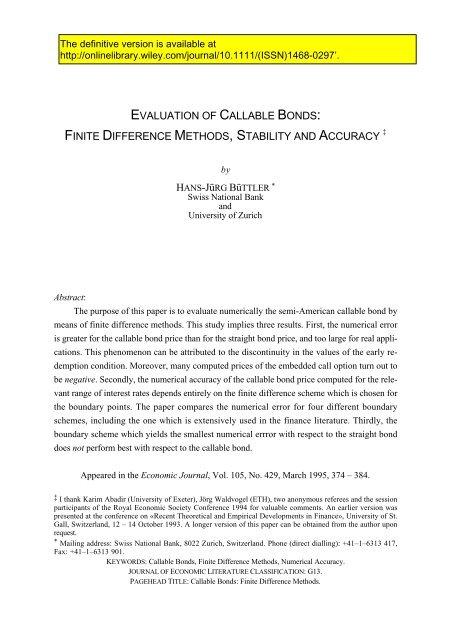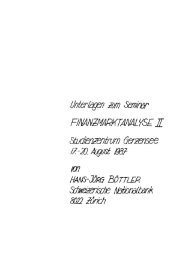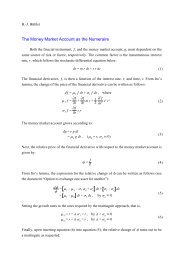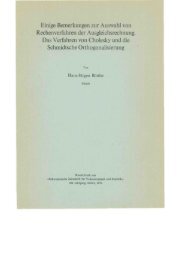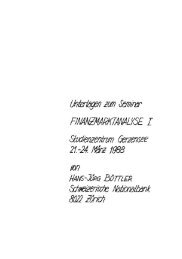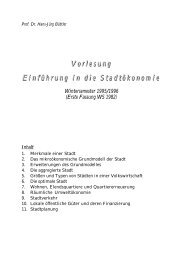Callable Bond/EJ/e
Callable Bond/EJ/e
Callable Bond/EJ/e
Create successful ePaper yourself
Turn your PDF publications into a flip-book with our unique Google optimized e-Paper software.
EVALUATION OF CALLABLE BONDS:<br />
FINITE DIFFERENCE METHODS, STABILITY AND ACCURACY ‡<br />
by<br />
HANS-JüRG BüTTLER *<br />
Swiss National Bank<br />
and<br />
University of Zurich<br />
Abstract:<br />
The purpose of this paper is to evaluate numerically the semi-American callable bond by<br />
means of finite difference methods. This study implies three results. First, the numerical error<br />
is greater for the callable bond price than for the straight bond price, and too large for real applications.<br />
This phenomenon can be attributed to the discontinuity in the values of the early redemption<br />
condition. Moreover, many computed prices of the embedded call option turn out to<br />
be negative. Secondly, the numerical accuracy of the callable bond price computed for the relevant<br />
range of interest rates depends entirely on the finite difference scheme which is chosen for<br />
the boundary points. The paper compares the numerical error for four different boundary<br />
schemes, including the one which is extensively used in the finance literature. Thirdly, the<br />
boundary scheme which yields the smallest numerical errror with respect to the straight bond<br />
does not perform best with respect to the callable bond.<br />
Appeared in the Economic Journal, Vol. 105, No. 429, March 1995, 374 – 384.<br />
‡ I thank Karim Abadir (University of Exeter), Jörg Waldvogel (ETH), two anonymous referees and the session<br />
participants of the Royal Economic Society Conference 1994 for valuable comments. An earlier version was<br />
presented at the conference on «Recent Theoretical and Empirical Developments in Finance», University of St.<br />
Gall, Switzerland, 12 – 14 October 1993. A longer version of this paper can be obtained from the author upon<br />
request.<br />
* Mailing address: Swiss National Bank, 8022 Zurich, Switzerland. Phone (direct dialling): +41–1–6313 417,<br />
Fax: +41–1–6313 901.<br />
KEYWORDS: <strong>Callable</strong> <strong>Bond</strong>s, Finite Difference Methods, Numerical Accuracy.<br />
JOURNAL OF ECONOMIC LITERATURE CLASSIFICATION: G13.<br />
PAGEHEAD TITLE: <strong>Callable</strong> <strong>Bond</strong>s: Finite Difference Methods.
H.-J. Büttler: <strong>Callable</strong> <strong>Bond</strong>s: Finite Difference Methods 1<br />
I. INTRODUCTION<br />
The callable bond is a straight (coupon) bond with the provision that allows the debtor to<br />
buy back or to ‘call’ the bond for a specified amount, the call price, plus the accrued interest<br />
since the last coupon date at some time, the call date(s), during the life of the bond. Three types<br />
of callable bonds can be observed in financial markets. The American callable bond may be repurchased<br />
at any time on or before the final redemption day, in contrast to the European or<br />
semi-American counterparts, which may only be called at one or several specific dates, respectively.<br />
In the case of semi-American bonds, the debtor gives the bondholder two months’ notice.<br />
The callable bond can be viewed as a compound security which consists of an otherwise<br />
identical straight bond and of an embedded call option, which is not traded and the price of<br />
which is, therefore, not observable. The embedded call option, which is written on the underlying<br />
straight bond, can be viewed as being ‘sold’ by the initial bondholder to the issuer of the<br />
callable bond, the debtor. Hence, the price of the callable bond must be equal to the price of the<br />
underlying straight bond less the price of the embedded call option at any time.<br />
This paper is motivated by our experience with finite difference methods as well as the<br />
wrong numerical results which have been published in two studies. Gibson-Asner (1990, Table<br />
6, p. 666) reports the computed prices of two almost identical embedded call options for various<br />
points in time. These two options are identical except for the last possible redemption dates<br />
which differ by roughly three months. The prices of these two options with, e. g., approximately<br />
eight years until expiration are reported to be {15.3192, 5.3789}. Our computation indicates<br />
that these two prices differ by 0.2 only. In Leithner (1992, Fig. 5.5, p. 145), the computed<br />
price of the semi-American call option is less than that of the corresponding European call<br />
for small interest rates, but greater for large interest rates. These wrong results presented in<br />
Gibson-Asner and Leithner must be due to numerical errors.<br />
The purpose of this paper is to evaluate numerically the semi-American callable bond by<br />
means of four finite difference methods. As an example, we use the one-factor model of the<br />
(real) term structure of interest rates proposed by Vasicek (1977). The numerical solution of the<br />
finite difference method will be compared with the analytical solution which was derived in<br />
Büttler and Waldvogel (1993a, b).<br />
The outline of the paper is as follows. The next section describes the callable bond price<br />
model. The finite difference methods considered in this paper are explained in the third section,<br />
followed by a section which addresses the question of numerical accuracy of the finite difference<br />
methods. Conclusions are given at the end.<br />
II. THE CALLABLE BOND PRICE MODEL<br />
Vasicek (1977) derives the following parabolic partial differential equation to determine<br />
the price of a default-free discount bond, P(r, τ), promising to pay one unit of money on the<br />
maturity day:<br />
P τ<br />
= 1<br />
2 ρ 2 P rr<br />
+ α (γ – r) + ρq P r<br />
– rP, (1)<br />
Royal Economic Society Conference University of Exeter, 28 – 31 March 1994
H.-J. Büttler: <strong>Callable</strong> <strong>Bond</strong>s: Finite Difference Methods 2<br />
where the subscripts denote partial derivatives, r the instantaneous interest rate, τ the remaining<br />
time period until the expiration of the discount bond, and q the market price of interest-rate risk<br />
assumed to be constant. If arbitrage opportunities are ruled out, the market price of interest-rate<br />
risk must be the same for all discount bonds of different maturities. Empirically, we would expect<br />
q to be positive. The remaining parameters are those of the underlying interest rate process,<br />
namely the Ornstein-Uhlenbeck process dr = α [γ – r] dt + ρ dz, with α > 0 the speed of adjustment,<br />
γ > 0 the long-run ‘equilibrium’ value of the instantaneous interest rate, t the calendar<br />
time, ρ > 0 the constant instantaneous standard deviation (volatility) of the instantaneous interest<br />
rate, and dz the Gauss-Wiener process.<br />
On the maturity day, the price of the discount bond is equal to one: this is the ‘initial’<br />
condition of (1), noting that ‘time’ τ is measured backwards. The boundary conditions, which<br />
lead to Vasicek’s bond price formula, are given by (i) P(r, τ) → 0 as r → ∞, right boundary<br />
(Brennan and Schwartz, 1977; 1979), and (ii) P(r, τ) = (e – ϑ r ), ϑ > 0, as r → – ∞, left<br />
boundary (Büttler and Waldvogel, 1993a). The right boundary condition says that the price of a<br />
discount bond tends to zero as the instantaneous interest rate grows infinitely large. The left<br />
boundary condition ensures that a particular solution is chosen which grows exponentially at<br />
most as the absolute value of the interest rate becomes very large.<br />
The callable bond satisfies the same partial differential (1) and the same boundary conditions<br />
as the discount bond between the notice dates. On the ‘initial’ day, i. e., the last possible<br />
redemption date, the price of the callable bond is equal to the face value plus the last coupon.<br />
Moreover, the callable bond is subject to the early redemption condition prevailing on each notice<br />
day when the debtor has to decide whether or not to call the bond. The call policy is optimal<br />
if the issuer of the callable bond minimizes his outstanding debt. Therefore, he will call the<br />
bond if the price of the callable bond is greater than the time value of the call price (including the<br />
next coupon). The ‘break-even’ (or critical) interest rate is that interest rate which equates the<br />
price of the callable bond an instant before the notice date (looking backwards in time) and the<br />
time value of the call price. Hence, the price of the callable bond an instant after the notice day<br />
is either equal to the time value of the call price if the actual interest rate is less than the ‘breakeven’<br />
interest rate or equal to the callable bond price an instant before the notice date if the actual<br />
interest rate is greater than the ‘break-even’ interest rate. This is the early redemption condition.<br />
III. FINITE DIFFERENCE METHODS<br />
Four different finite difference methods have been applied to the partial differential equation<br />
(1), namely the explicit method, the implicit method, the Crank-Nicolson method and the<br />
implicit method with a two time-level extrapolation due to Lawson and Morris (1978), henceforth<br />
the Lawson-Morris method. Brennan and Schwartz (1978) have shown that the explicit<br />
method corresponds to the simple binomial model, in contrast to the implicit method which corresponds<br />
to a multinomial model with jumps.<br />
We use Brennan and Schwartz’ (1979) transformation of variables:<br />
Royal Economic Society Conference University of Exeter, 28 – 31 March 1994
H.-J. Büttler: <strong>Callable</strong> <strong>Bond</strong>s: Finite Difference Methods 3<br />
x =<br />
1<br />
1 + mr , τ = t – t 0<br />
s – t 0<br />
, (0 ≤ x, τ ≤ 1), F(x, τ) = P(r, t). (2)<br />
Here, m;^ is a scaling factor, s the maximum time until expiration of all the bonds considered,<br />
and τ measures the elapsed time rather than the time to maturity (the differential equation is still<br />
solved backwards in time). The transformed differential equation then becomes (3).<br />
0 =<br />
∂F(x, τ)<br />
∂τ<br />
+ a(x)<br />
∂F(x, τ)<br />
∂x<br />
+ b(x) ∂2 F(x, τ)<br />
∂x 2<br />
+ c(x) F(x, τ), with<br />
a(x) = – (αγ + ρq) m x 2 – α (1 – x) x – ρ 2 m 2 x 3 (s – t 0<br />
) 0,<br />
b(x) = 1<br />
2 ρ 2 m 2 x 4 (1 – x)<br />
(s – t 0<br />
) > 0, c(x) = – (s – t 0<br />
) < 0.<br />
mx<br />
(3)<br />
Two comments are necessary. First, although we consider only non-negative interest rates in<br />
this paper, the transformation (2) allows for a negative interest rate range which is sufficient in<br />
practical applications, for instance, r > –100% for m;^ = 1. In fact, a calculation of the analytical<br />
price of a callable bond with twenty years to expiration and with ten call dates has shown that<br />
the smallest ‘break-even’ interest rate is –13% (Büttler and Waldvogel, 1993b). Secondly, the<br />
numerical error calculated in this paper is based on the analytical price for positive ‘break-even’<br />
interest rates (see footnote 3 of Table 3).<br />
Table 1: Finite Differences for Internal Mesh Points.<br />
Derivative Denominator F i + 1<br />
F i<br />
F i – 1<br />
Equal Interest F x 2 ∆x 1 — – 1<br />
Rate Interval F xx (∆x) 2 1 – 2 1<br />
Unequal Interest F x<br />
∆x + ∆x 0 1 — – 1<br />
Rate Interval F xx<br />
∆x ∆x 0<br />
[∆x + ∆x 0<br />
] 2 ∆x 0<br />
– 2 [∆x + ∆x 0<br />
] 2 ∆x<br />
Comment: Read the second row as F x<br />
= [1·F i + 1<br />
– 1·F i – 1<br />
] / [2 ∆x] and similarly the other rows. ∆x 0<br />
denotes the<br />
interval length to the left of the internal mesh point in question and ∆x the interval length to the right of this<br />
mesh point.<br />
The region of definition of the transformed differential equation, Ω = [0, 1] × [0, 1], is<br />
now divided into meshes. Since we wish to calculate the price of callable bonds for the current<br />
value of the instantaneous interest rate, the meshes are not all of the same size. Moreover, it<br />
might be desirable to have narrow meshes for small interest rates such that the ‘break-even’ interest<br />
rate can be determined with ‘high’ accuracy. Therefore, the x-axis is divided into n 1<br />
equal<br />
intervals between x m<br />
and 1 (equivalently r ∈ [0, r m<br />
]) and n 2<br />
equal intervals between 0 and x m<br />
(equivalently r ∈ [r m<br />
, + ∞]). If n 2<br />
is set equal to zero, then the whole range of positive interest<br />
rates is divided into n 1<br />
equal intervals, possibly except for an initial step at x = 0 (r = ∞). The<br />
current value of the instantaneous interest rate, r 0<br />
, lies always on a mesh point. The steps between<br />
two points in time of interest (e. g., a coupon date and a notice date) will be of equal<br />
length. The mesh points are counted with index i along the x-axis and with index j along the<br />
time axis.<br />
Royal Economic Society Conference University of Exeter, 28 – 31 March 1994
H.-J. Büttler: <strong>Callable</strong> <strong>Bond</strong>s: Finite Difference Methods 4<br />
The standard second-order finite differences are applied to (3), namely F τ<br />
= [F j + 1<br />
– F j<br />
] /<br />
∆τ for the partial derivative with respect to time, and those of Table 1 for the partial derivatives<br />
with respect to the interest rate (Smith, 1985; for unequal interest-rate intervals see Schwarz,<br />
1988). For further reference, the mesh ratio is defined to be ψ = ∆τ / (∆x) 2 .<br />
The left boundary condition of the transformed differential equation is F 0 j = 0 for all j. The<br />
right boundary condition of the transformed differential equation (3) is obtained in the following<br />
way. First, note that the transformed differential equation is regular at x = 1, that is, F,<br />
F x<br />
and F xx<br />
are finite at x = 1. Hence, the fourth term of (3) vanishes. Secondly, the partial<br />
derivatives on the right boundary may be approximated by various boundary schemes (Stiefel,<br />
1965; Schwarz, 1988). Unfortunately, these boundary schemes do not have the same local<br />
truncation error as the finite difference approximation at internal mesh points because no points<br />
outside of the region of definition can be taken into account. We tried the five simplest boundary<br />
schemes for i = n (x = 1) which are shown in Table 2. The second boundary scheme is a<br />
complete second-order finite difference approximation. However, it constrains the second partial<br />
derivatives at the points (n, ·) and (n – 1, ·) to be equal. This restriction, which is similar to<br />
the ‘not-a-knot’ condition used for cubic splines (De Boor, 1978), helps to stabilize possible<br />
oscillations. The first boundary scheme, which is extensively used in the finance literature (see,<br />
e. g., Brennan and Schwartz, 1977, 1979; Courtadon, 1982; Duffie, 1992), imposes the same<br />
restriction with respect to the second partial derivative as the second boundary scheme. Moreover,<br />
the first partial derivative of the first boundary scheme applies to the point (n – 1/2, ·)<br />
rather than to the point (n, ·). The third boundary scheme is, in principle, equivalent to the one<br />
for the internal mesh points: the first partial derivative is of the same second order and the second<br />
partial derivatives at the points (n, ·) and (n – 1, ·) are not restricted to be equal. However,<br />
the second partial derivative of this finite difference scheme is now of the third order. The<br />
fourth boundary scheme is of the third order for both partial derivatives, and finally, the fifth<br />
boundary scheme of the fourth order. In summary, none of the five boundary schemes considered<br />
in Table 2 is fully compatible with the finite difference scheme for the internal mesh points.<br />
The choice of one of them is, therefore, at the user’s discretion.<br />
IV. THE ACCURACY OF FINITE DIFFERENCE METHODS<br />
We look first at the stability of the boundary schemes. Numerical experiments for a discount<br />
bond indicate that the first four boundary schemes seem to be stable for all four finite difference<br />
methods considered in this paper, that is, the numerical error shrinks as the meshes get<br />
smaller, holding the mesh ratio constant. However, the fifth boundary scheme seems to be unstable:<br />
the numerical error grows infinitely large (although very slowly) as the meshes get<br />
smaller, holding the mesh ratio constant. This might be due to the fact that the local truncation<br />
error of the fifth boundary scheme is much smaller than that of the internal mesh points. The<br />
fifth boundary scheme is neglected in the following.<br />
Royal Economic Society Conference University of Exeter, 28 – 31 March 1994
H.-J. Büttler: <strong>Callable</strong> <strong>Bond</strong>s: Finite Difference Methods 5<br />
It is well known that the explicit mehod is unstable for ‘big’ mesh ratios (Smith, 1985).<br />
Since small mesh ratios require a great deal of time steps, the explicit method is computationally<br />
not efficient. With this respect, the other three finite difference methods considered in this paper<br />
are preferable. Although these three methods are stable for any mesh ratio, they may exhibit<br />
slowly decaying finite oscillations in the neighbourhood of discontinuities in the initial values or<br />
between initial values and boundary values (Smith, 1985). Indeed, our own computations indicate<br />
that oscillations occur after each coupon date of the straight bond for large mesh ratios, especially<br />
with the Crank-Nicolson method. The results to follow refer to the Lawson-Morris<br />
method which performs slightly best.<br />
The numerical accuracy of the finite difference methods under consideration when applied<br />
to the callable bond is rather poor, given a number of interest-rate intervals which is both comparable<br />
with similar problems (Gourlay and Morris, 1980) and computationally feasible. Moreover,<br />
we find that many computed prices of the embedded call option turn out to be negative, in<br />
particular for the third and fourth boundary schemes.<br />
What is the reason for the poor numerical accuracy or the negative prices? We explain this<br />
phenomenon by the discontinuity in the values of the early redemption condition. A closer look<br />
at the evolution of the price vector of a particular callable bond in time reveals this fact quite impressively.<br />
To bear out this assertion most clearly, we chose a European callable bond, the analytical<br />
price of which can be computed with approximate machine precision (Büttler and Waldvogel,<br />
1993a, b). The European callable bond under consideration has a maximum life of 6.811<br />
years until the final expiration date and bears an annual coupon of 7%. Proceeding backwards<br />
in time, we stop the calculation for the first time an instant before the notice day and look at the<br />
numerical error of the callable bond as shown in Fig. 1. The instantaneous interest rate ranges<br />
between zero and 200% in the panel (a). The same function is shown in the panel (b) in a magnified<br />
mode for interest rates between zero and 15%. One time step after the notice day, the<br />
numerical error has a spike at the ‘break-even’ interest rate as shown in Fig. 2. Although this<br />
spike broadens and spreads out over the next few time steps, it introduces slowly decaying finite<br />
oscillations which amplify the numerical error of the callable bond compared with that of<br />
the underlying straight bond as shown in Fig. 3 – 5. We conclude that the difference in accuracy<br />
between the callable bond and its underlying straight bond is entirely due to the discontinuity<br />
in the values of the early redemption condition. The numerical errors for a small sample of<br />
exchange-traded callable bonds are shown in Table 3.<br />
V. CONCLUSIONS<br />
This study implies three results. First, the numerical error is greater for the callable bond<br />
price than for the straight bond price, and too large for real applications which require a twodigit<br />
accuracy at least. This phenomenon can be attributed to the discontinuity in the values of<br />
the early redemption condition. Moreover, many computed prices of the embedded call option<br />
turn out to be negative. The phenomenon of negative computed prices of the embedded call op-<br />
Royal Economic Society Conference University of Exeter, 28 – 31 March 1994
H.-J. Büttler: <strong>Callable</strong> <strong>Bond</strong>s: Finite Difference Methods 6<br />
tion has also been observed, but has not been explained, in Gibson-Asner (1990, p. 670). In an<br />
empirical study, Longstaff (1992) finds that ‘nearly two-thirds of the call values implied by a<br />
sample of recent callable bond prices are negative.’ Our own computations indicate that all but<br />
two call option prices implied by the sample of Table 3 are negative. We argue that the negative<br />
computed or implied prices of the embedded call option might be due to the numerical error of<br />
the finite difference methods under consideration.<br />
Secondly, the numerical accuracy of the callable bond price computed for the relevant<br />
range of interest rates depends entirely on the finite difference scheme which is chosen for the<br />
boundary points (see Fig. 1 – 5).<br />
Thirdly, the boundary scheme which yields the smallest numerical errror with respect to<br />
the straight bond does not perform best with respect to the callable bond. The boundary scheme<br />
#4 has the smallest root mean square error with respect to the underlying straight bond for the<br />
sample of Table 3, in contrast to the boundary scheme #2 which has the smallest root mean<br />
square error with respect to the callable bond. Since, in general, you do not know the analytical<br />
solution of the partial differential equation in question, you would probably choose that boundary<br />
scheme which gives you the smallest numerical error with respect to a similar security with<br />
a known analytical solution, that is, the straight bond. However, this choice is misleading.<br />
REFERENCES<br />
Brennan, M. J. and Schwartz, E. S. (1977). ‘Savings <strong>Bond</strong>s, Retractable <strong>Bond</strong>s and <strong>Callable</strong> <strong>Bond</strong>s’, Journal of Financial<br />
Economics, vol. 5, pp. 67 – 88.<br />
Brennan, M. J. and Schwartz, E. S. (1978). ‘Finite Difference Methods and Jump Processes Arising in the Pricing of<br />
Contingent Claims: A Synthesis’, Journal of Financial and Quantitative Analysis, vol. 13, pp. 461 – 474.<br />
Brennan, M. J. and Schwartz, E. S. (1979). ‘A Continuous Time Approach to the Pricing of <strong>Bond</strong>s’, Journal of Banking<br />
and Finance, vol. 3, pp. 133 – 155.<br />
Büttler, H.-J. and Waldvogel, J. (1993a). ‘Pricing the European and Semi-American <strong>Callable</strong> <strong>Bond</strong> by means of Series<br />
Solutions of Parabolic Differential Equations’, mimeo, Swiss National Bank.<br />
Büttler, H.-J. and Waldvogel, J. (1993b). ‘Numerical Evaluation of <strong>Callable</strong> <strong>Bond</strong>s Using Green’s Function’, mimeo,<br />
Swiss National Bank.<br />
Courtadon, G. (1982). ‘The Pricing of Options on Default-free <strong>Bond</strong>s’, Journal of Financial and Quantitative Analysis,<br />
vol. XVII, pp. 75 – 101.<br />
De Boor, C. (1978). A Practical Guide to Splines, New York: Springer-Verlag.<br />
Duffie, D. (1992). Dynamic Asset Pricing Theory, Princeton (N. J.): Princeton University Press.<br />
Gibson-Asner, R. (1990). ‘Valuing Swiss Default-free <strong>Callable</strong> <strong>Bond</strong>s’, Journal of Banking and Finance, vol. 14, pp.<br />
649 – 672.<br />
Gourlay, A. R. and Morris, J. Ll. (1980). ‘The Extrapolation of First Order Methods for Parabolic Partial Differential<br />
Equations, II’, SIAM Journal of Numerical Analysis, vol. 17 (no. 5), pp. 641 – 655.<br />
Jensen, K. and Wirth, N. (1982). Pascal: User Manual and Report, New York: Springer-Verlag, second edition.<br />
Lawson, J. D. and Morris, J. Ll. (1978). ‘The Extrapolation of First Order Methods for Parabolic Partial Differential<br />
Equations, I’, SIAM Journal of Numerical Analysis, vol. 15 (no. 7), pp. 1212 – 1224.<br />
Leithner, S. (1992). Valuation and Risk Management of Interest Rate Derivative Securities, Bern: Verlag Paul Haupt.<br />
Longstaff, F. (1992). ‘Are Negative Option Prices Possible? The <strong>Callable</strong> U. S. Treasury-<strong>Bond</strong> Puzzle’, Journal of Business,<br />
vol. 65, pp. 571 – 592.<br />
Press, W. H., Flannery, B. P., Teukolsky, S. A. and Vetterling, W. T. (1989). Numerical Recipes in Pascal: The Art of<br />
Scientific Computing, Cambridge (Mass.): Cambridge University Press.<br />
Smith, G. D. (1985). Numerical Solution of Partial Differential Equations: Finite Difference Methods, Oxford: Clarendon<br />
Press, third edition.<br />
Schwarz, H. R. (1988). Numerische Mathematik, Stuttgart: B. G. Teubner, second edition.<br />
Stiefel, E. (1965). Einführung in die numerische Mathematik, Stuttgart: B. G. Teubner.<br />
Vasicek, O. (1977). ‘An Equilibrium Characterization of the Term Structure’, Journal of Financial Economics, vol. 5,<br />
pp. 177 – 188.<br />
Royal Economic Society Conference University of Exeter, 28 – 31 March 1994
H.-J. Büttler: <strong>Callable</strong> <strong>Bond</strong>s: Finite Difference Methods 7<br />
Table 3: Price of <strong>Callable</strong> <strong>Bond</strong>s Belonging to ‘<strong>Bond</strong> Baskets’ of the SWISS NATIO-<br />
NAL BANK and Numerical Error of Finite Difference Methods. 1<br />
Number Name of Security Years Number Call Price of <strong>Callable</strong> <strong>Bond</strong><br />
of to of Call Condi- Analy- Finite Difference Method<br />
Security Maturity 2 Dates 3 tion 4 tical 5 #1 #2<br />
Col. 1 Col. 2 Col. 3 Col. 4 Col. 5 Col. 6 Col. 7 Col. 8<br />
16 310 4 1/2% Bern 1986–1998 6.547 2 (1) A 84.57 81.41 82.60<br />
16 242 4 1/4% Bern 1987–1999 7.519 2 (1) A 82.55 79.54 80.75<br />
16 506 5 1/4% Graub. 89–1999 7.728 2 (2) A 85.67 85.23 86.34<br />
17 459 4 1/4% Waadt 1986–1998 6.269 2 (1) A 83.66 80.38 81.58<br />
17 360 4 1/4% Wallis 1986–1998 6.478 2 (1) A 83.45 80.20 81.41<br />
17 364 7% Wallis 1990–2000 8.811 2 (2) A 95.68 91.39 93.04<br />
17 610 6 1/2% Zürich 1991–2001 9.322 2 (2) A 93.17 93.90 90.59<br />
15 461 4 3/4% Eidg. 1986–2001 9.036 5 (1) B 84.63 82.30 83.38<br />
15 710 4 1/4% Eidg. 1986–2001 9.292 5 (1) B 81.32 78.94 80.04<br />
15 712 4 1/4% Eidg. 1986–2011 19.942 10 (1) C 76.76 78.63 78.40<br />
15 718 4 1/4% Eidg. 1987–2012 20.172 10 (1) C 76.67 78.62 78.37<br />
15 722 4% Eidg. 1988–1999 7.117 3 (1) D 81.63 78.43 79.67<br />
15 726 4 1/4% Eidg. 1989–2001 9.050 4 (1) E 81.50 79.02 80.14<br />
15 736 5 1/2% Eidg. 1989–1998 6.819 2 (2) A 86.96 86.49 87.59<br />
15 738 5 1/2% Eidg. 1990–1999 7.042 2 (2) A 86.98 86.54 87.64<br />
15 740 6 1/4% Eidg. 1990–2000 8.208 2 (2) A 91.05 91.33 92.34<br />
15 745 6 1/2% Eidg. 1990–2000 8.378 2 (2) A 92.49 92.97 89.60<br />
15 227 6 1/2% Eidg. 1990–1999 7.564 2 (2) A 91.93 92.23 88.82<br />
15 747 6 3/4% Eidg. 1991–2001 9.081 2 (2) A 94.50 91.95 91.83<br />
15 749 6 1/4% Eidg. 1991–2001 9.228 2 (2) A 91.62 92.18 93.12<br />
15 751 6 1/4% Eidg. 1991–2003 11.400 4 (2) E 92.87 94.12 91.89<br />
15 753 6 1/4% Eidg. 1991–2002 10.561 2 (2) A 92.39 93.36 94.17<br />
1 Trading day 23 December 1991. Given the current value of the instantaneous interest rate and three observed<br />
continuous-time discount bond yields {0.075228, 0.07753, 0.06647, 0.06298} with {0, 1.0, 7.175, 10.25} years<br />
until expiration, the parameters of Vasicek’s theoretical yield curve have been estimated by means of a modified<br />
Newton-Raphson algorithm. The underlying interest-rate process is the Ornstein-Uhlenbeck process dr = α (γ –<br />
r) dt + ρ dz, where r is the instantaneous interest rate and dz the Gauss-Wiener process. The estimated parameters<br />
of the term structure are: the speed of adjustment α = 0.4418, the long-run ‘equilibrium’ value of the instantaneous<br />
interest rate γ = 0.03485 [discrete-time equivalent 3.546% p. a.], the volatility of the instantaneous interest<br />
rate ρ = 0.1326, and the market price of interest-rate risk q = 0.2117. The instantaneous interest rate has been<br />
approximated by the tomorrow-next rate; it was r 0<br />
= 0.075228 [discrete-time equivalent 7.813% p. a.] on the<br />
trading day in question. The bonds in the upper panel have been issued by cantons, those in the lower panel by<br />
the Swiss confederation.<br />
2 Maximum time period until maturity.<br />
3 The numbers in brackets denote the numbers of positive ‘break-even’ interest rates. These numbers have been<br />
employed to compute the analytical prices for this Table because the finite difference methods are applied to the<br />
partial differential equation with non-negative interest rates only.<br />
4 Call condition type A: the call price is equal to 100 at both call dates. Call condition type B: the first call<br />
price (when moving forwards in time) is equal to 101.5; annual reduction of 0.5 percentage points until 100.<br />
Call condition type C: the first call price (when moving forwards in time) is equal to 102.5; annual reduction of<br />
0.5 percentage points until 100. Call condition type D: the first call price (when moving forwards in time) is<br />
equal to 100.5; annual reduction of 0.5 percentage points until 100. Call condition type E: the first call price<br />
(when moving forwards in time) is equal to 101; annual reduction of 0.5 percentage points until 100. There is a<br />
notice period of two months for all call conditions.<br />
Royal Economic Society Conference University of Exeter, 28 – 31 March 1994
H.-J. Büttler: <strong>Callable</strong> <strong>Bond</strong>s: Finite Difference Methods 8<br />
Table 3: Continued. Price of <strong>Callable</strong> <strong>Bond</strong>s Belonging to ‘<strong>Bond</strong> Baskets’ of the<br />
SWISS NATIONAL BANK and Numerical Error.<br />
Number Name of Security Price of <strong>Callable</strong> <strong>Bond</strong> Percentage Error of Finite Difference Method<br />
of with Bound. Scheme #… 6 Boundary Scheme<br />
Security #3 #4 #1 7 #2 8 #3 9 #4 10<br />
Col. 1 Col. 2 Col. 9 Col. 10 Col. 11 Col. 12 Col. 13 Col. 14<br />
16 310 4 1/2% Bern 1986–1998 92.84 91.12 – 3.7 – 2.3 + 9.8 + 7.7<br />
16 242 4 1/4% Bern 1987–1999 91.27 89.43 – 3.6 – 2.2 + 10.6 + 8.3<br />
16 506 5 1/4% Graub. 89–1999 95.16 93.48 – 0.5 + 0.8 + 11.1 + 9.1<br />
17 459 4 1/4% Waadt 1986–1998 92.19 90.46 – 3.9 – 2.5 + 10.2 + 8.1<br />
17 360 4 1/4% Wallis 1986–1998 92.06 90.30 – 3.9 – 2.4 + 10.3 + 8.2<br />
17 364 7% Wallis 1990–2000 103.10 101.74 – 4.5 – 2.8 + 7.8 + 6.3<br />
17 610 6 1/2% Zürich 1991–2001 100.85 99.46 + 0.8 – 2.8 + 8.2 + 6.7<br />
15 461 4 3/4% Eidg. 1986–2001 96.79 94.35 – 2.8 – 1.5 + 14.4 + 11.5<br />
15 710 4 1/4% Eidg. 1986–2001 95.33 92.71 – 2.9 – 1.6 + 17.2 + 14.0<br />
15 712 4 1/4% Eidg. 1986–2011 91.08 88.62 + 2.4 + 2.1 + 18.7 + 15.4<br />
15 718 4 1/4% Eidg. 1987–2012 90.77 88.36 + 2.5 + 2.2 + 18.4 + 15.2<br />
15 722 4% Eidg. 1988–1999 92.91 90.72 – 3.9 – 2.4 + 13.8 + 11.1<br />
15 726 4 1/4% Eidg. 1989–2001 94.32 91.74 – 3.0 – 1.7 + 15.7 + 12.6<br />
15 736 5 1/2% Eidg. 1989–1998 96.21 94.61 – 0.5 + 0.7 + 10.6 + 8.8<br />
15 738 5 1/2% Eidg. 1990–1999 96.25 94.63 – 0.5 + 0.8 + 10.7 + 8.8<br />
15 740 6 1/4% Eidg. 1990–2000 99.39 97.88 + 0.3 + 1.4 + 9.2 + 7.5<br />
15 745 6 1/2% Eidg. 1990–2000 100.54 99.08 + 0.5 – 3.1 + 8.7 + 7.1<br />
15 227 6 1/2% Eidg. 1990–1999 100.16 98.69 + 0.3 – 3.4 + 8.9 + 7.3<br />
15 747 6 3/4% Eidg. 1991–2001 102.05 100.68 – 2.7 – 2.8 + 8.0 + 6.5<br />
15 749 6 1/4% Eidg. 1991–2001 99.58 98.14 + 0.6 + 1.6 + 8.7 + 7.1<br />
15 751 6 1/4% Eidg. 1991–2003 102.09 99.99 + 1.3 – 1.1 + 9.9 + 7.7<br />
15 753 6 1/4% Eidg. 1991–2002 99.67 98.37 + 1.1 + 1.9 + 7.9 + 6.5<br />
Root Mean Square Error for the <strong>Callable</strong> <strong>Bond</strong>s 2.6 2.1 11.8 9.6<br />
Root Mean Square Error for the Underlying Straight <strong>Bond</strong>s 11 1.8 1.5 1.2 0.9<br />
5 Price obtained from the analytical solution by means of numerical quadrature involving Green’s function<br />
(Büttler and Waldvogel, 1993a, b) minus the accrued interest since the last coupon date. See footnote 3. All the<br />
digits displayed are correct (the accuracy is almost equal to the machine precision).<br />
6 Price obtained from the numerical solution of the partial differential equation by means of the Lawson-Morris<br />
method minus the accrued interest since the last coupon date. The parameters of the finite difference method are:<br />
n 1<br />
= 50, n 2<br />
= 50, ψ = 200, s = 10, m;^ = 1, and r m<br />
= 0.15. Actually, the computer program modifies slightly<br />
these parameters as described in the longer version of this paper. The computer program has been written in PAS-<br />
CAL (Jensen and Wirth, 1978) and runs on the APPLE® MACINTOSH family, the machine precision of which<br />
is 19 – 20 decimal digits (mantissa of the floating-point form). The tridiagonal matrix algorithm of Press et al.<br />
(1989) has been applied to the resulting equation system of the four finite difference methods under consideration.<br />
7 Percentage deviation: (col. 7 / col. 6 – 1) * 100.<br />
8 Percentage deviation: (col. 8 / col. 6 – 1) * 100.<br />
9 Percentage deviation: (col. 9 / col. 6 – 1) * 100.<br />
10 Percentage deviation: (col. 10 / col. 6 – 1) * 100.<br />
11 The analytical price of the underlying straight bond has been obtained from Vasicek’s bond price model minus<br />
the accrued interest since the last coupon date. The numerical price of the underlying straight bond has been<br />
obtained from the numerical solution of the partial differential equation by means of the Lawson-Morris method<br />
minus the accrued interest since the last coupon date. The parameters of the finite difference method are the same<br />
as those given in footnote 6.<br />
Royal Economic Society Conference University of Exeter, 28 – 31 March 1994
H.-J. Büttler: <strong>Callable</strong> <strong>Bond</strong>s: Finite Difference Methods 9<br />
0.00<br />
#3 & #4<br />
0.00<br />
#4<br />
#3<br />
Percentage Error<br />
-0.05<br />
-0.10<br />
#2<br />
#1<br />
Percentage Error<br />
-0.05<br />
-0.10<br />
#2<br />
#1<br />
-0.15<br />
0.0<br />
(a)<br />
0.5<br />
1.0<br />
Interest Rate<br />
1.5<br />
2.0<br />
-0.15<br />
0.00<br />
Fig. 1a & b: Percentage Error on the Notice Day. ‡<br />
(b)<br />
0.05 0.10<br />
Interest Rate<br />
0.15<br />
0.05<br />
0.05<br />
Percentage Error<br />
0.00<br />
-0.05<br />
0.0<br />
#3 & #4<br />
#1 & #2<br />
0.5 1.0<br />
Interest Rate<br />
1.5<br />
(a)<br />
2.0<br />
Percentage Error<br />
0.00<br />
-0.05<br />
0.00<br />
#4<br />
(b)<br />
#2<br />
#3<br />
0.05 0.10<br />
Interest Rate<br />
Fig. 2a & b: Percentage Error One Time Step after the Notice Day. ‡<br />
#1<br />
0.15<br />
3<br />
3<br />
2<br />
2<br />
#3<br />
Percentage Error<br />
1<br />
0<br />
-1<br />
-2<br />
0.0<br />
#3 & #4<br />
#1 & #2<br />
0.5 1.0<br />
Interest Rate<br />
1.5<br />
(a)<br />
2.0<br />
Percentage Error<br />
1<br />
0<br />
-1<br />
-2<br />
0.00<br />
#2<br />
#4<br />
#1<br />
0.05 0.10<br />
Interest Rate<br />
(b)<br />
0.15<br />
Fig. 3a & b: Percentage Error after Two Years. ‡<br />
‡ The numbers refer to the boundary schemes of Table 2. The parameters of the Lawson-Morris method are n 1<br />
= 50, r m = 0.15, n 2 = 50, ψ = 200, ∆t = 1/74th of a year, s = 10 and m;^ = 1.<br />
Royal Economic Society Conference University of Exeter, 28 – 31 March 1994
H.-J. Büttler: <strong>Callable</strong> <strong>Bond</strong>s: Finite Difference Methods 10<br />
Percentage Error<br />
5<br />
4<br />
3<br />
2<br />
1<br />
0<br />
-1<br />
#4<br />
#2<br />
#3<br />
Percentage Error<br />
5<br />
4<br />
3<br />
2<br />
1<br />
0<br />
-1<br />
#4<br />
#2<br />
#3<br />
(b)<br />
-2<br />
-3<br />
0.0<br />
#1<br />
0.5 1.0<br />
Interest Rate<br />
1.5<br />
(a)<br />
2.0<br />
-2<br />
-3<br />
0.00<br />
#1<br />
0.05<br />
Interest Rate<br />
0.10<br />
0.15<br />
Fig. 4a & b: Percentage Error after 6.811 Years. ‡<br />
0.8<br />
0.8<br />
Percentage Error<br />
0.6<br />
0.4<br />
0.2<br />
0.0<br />
-0.2<br />
-0.4<br />
-0.6<br />
-0.8<br />
0.0<br />
#3<br />
#2<br />
#4<br />
0.5 1.0<br />
Interest Rate<br />
#1<br />
1.5<br />
(a)<br />
2.0<br />
Percentage Error<br />
0.6<br />
0.4<br />
0.2<br />
0.0<br />
-0.2<br />
-0.4<br />
-0.6<br />
-0.8<br />
0.00<br />
#4<br />
#3<br />
0.05<br />
Interest Rate<br />
Fig. 5a & b: Percentage Error of the Underlying Straight <strong>Bond</strong>. ‡<br />
#1<br />
#2<br />
0.10<br />
(b)<br />
0.15<br />
Table 2: Five Boundary Schemes.<br />
Scheme # Derivative Denominato F n<br />
F n – 1<br />
F n – 2<br />
F n – 3<br />
F n – 4<br />
r<br />
1 F x ∆x 1 – 1 — — —<br />
F xx (∆x) 2 1 – 2 1 — —<br />
2 F x 2 ∆x 3 – 4 1 — —<br />
F xx (∆x) 2 1 – 2 1 — —<br />
3 F x 2 ∆x 3 – 4 1 — —<br />
F xx (∆x) 2 2 – 5 4 – 1 —<br />
4 F x 6 ∆x 11 – 18 9 – 2 —<br />
F xx (∆x) 2 2 – 5 4 – 1 —<br />
5 F x 12 ∆x 25 – 48 36 – 16 3<br />
F xx 12 (∆x) 2 35 – 104 114 – 56 11<br />
‡ The numbers refer to the boundary schemes of Table 2. The parameters of the Lawson-Morris method are n 1<br />
= 50, r m = 0.15, n 2 = 50, ψ = 200, ∆t = 1/74th of a year, s = 10 and m;^ = 1.<br />
Royal Economic Society Conference University of Exeter, 28 – 31 March 1994
H.-J. Büttler: <strong>Callable</strong> <strong>Bond</strong>s: Finite Difference Methods 11<br />
Comment: Read the second row as F x<br />
= [1·F n<br />
– 1·F n – 1<br />
] / ∆x and similarly the other rows.<br />
Royal Economic Society Conference University of Exeter, 28 – 31 March 1994


